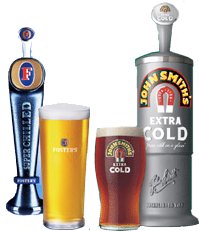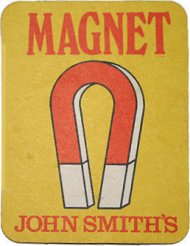 |

|
|

|
|
|
 |

home
about
features
A-Z
books

|

|

features
|

| |
Beer's big freeze
by Willard Clarke, 06/06
The Americanisation of British society gathers pace. A decade or more ago, I dropped into Jimmy Armstrong's Bar on 10th Avenue in Manhattan, New York City, famous for serving a good range of micro-brewery beers and imports from Europe.
I tried and enjoyed a few American craft brews but, encouraged by a nostalgic print on the wall of the Ind Coope & Allsopp brewery in Burton-on-Trent, I called for a glass of Bass Ale.
The beer was so cold it was undrinkable. I had to bring it up to a palatable temperature by warming it in the palms of my hands for five or 10 minutes.
I asked the barman the cellar temperature of the beer. "38 degrees," he replied, using Fahrenheit, or four degrees Celsius. Bass Ale is a keg beer brewed for the American market and you would expect it to be a tad cooler than a pint of kosher Draught Bass. But four degrees - that's strictly for the penguins.
Scroll forward to 2006 and view the wraparound advertisement adorning a recent copy of a pub trade newspaper. "Are you cold enough?" Scottish Courage asked as it paraded
a bevy of fonts, ice-blue in colour, for the likes of John Smith's Extra Cold, Strongbow Extra Cold, Foster's Super Chilled and - ooh la la - Kronenbourg 1664 Cold Premiere.
Bass Ale is now old hat and far too warm, for these Arctic brews are served at 3 degrees C. The penguins have won - or rather the American view of how beer should be served has won.
ScotCo's blurb for the ad tells us that nobody wants a warm beer (true) and that serving beer at 3 degrees C "meets consumer expectations" (wrong - as far as this consumer is concerned).
|
|

|
You can tell the drinkers who do want beer served this cold because their tongues are permanently glued to the roofs of their mouths, depriving them of speech.
The ad ran a series of alleged quotes from drinkers, telling us that beers served this cold are more refreshing. I dispute that and I also doubt whether many people can drink more than a single glass of ice-cold beer, which atrophies the taste buds and freezes the throat.
On my travels I once asked the brewmaster at Grolsch in the Netherlands at which temperature he recommended his Pilsener should be served. "Eight degrees," he replied emphatically. I agree. Lager beer, by the very nature of its production methods, needs to be served colder than ale. But you do need to taste the stuff.
A good quality lager will offer a delicate aroma and flavour of juicy malt, tangy hops and a touch of citrus fruit. These tempting attributes disappear beneath the ice floes when the temperature is dropped from eight to three degrees.
As for ale, this style of beer is ruined beyond recall when served at a close-to-freezing temperature. I doubt whether John Smith's Extra Cold is actually an ale at all and comes from the same production line as Foster's and Kronenbourg.
The long-matured advice of British master brewers is that cask beer should be served at 11-12 degrees. That is not, contrary to myth or global brewers' advertisements, warm but cool and refreshing. At that temperature, the richness and complexity of cask beer, with its biscuity malt, tangy fruit and aromatic, peppery hops come to the fore.

|
|
There used to be a splendid beer brewed at the John Smith's Tadcaster brewery called Magnet. I recall its pungent hop and orange fruit aroma and flavour to this day.
But the beer has disappeared. It was brewed for a while for ScotCo by the Burtonwood Brewery but is no longer listed there. Clearly it was taking up too much capacity at Tadcaster and was getting in the way of John Smith's Extra Cold.
That's a small tragedy, a sad loss. Fine, genuine ales -- brewed and served at sensible temperatures so that drinkers can actually taste them -- are being axed as the global brewers rush to satisfy just one, fickle section of the market: young people.
|
Next time I visit Jimmy Armstrong's Bar in Manhattan I'll probably find the Bass Ale is being served at two degrees.
And a crowd of penguins standing at the bar.
|
|
home
about
features
A-Z
books
|

